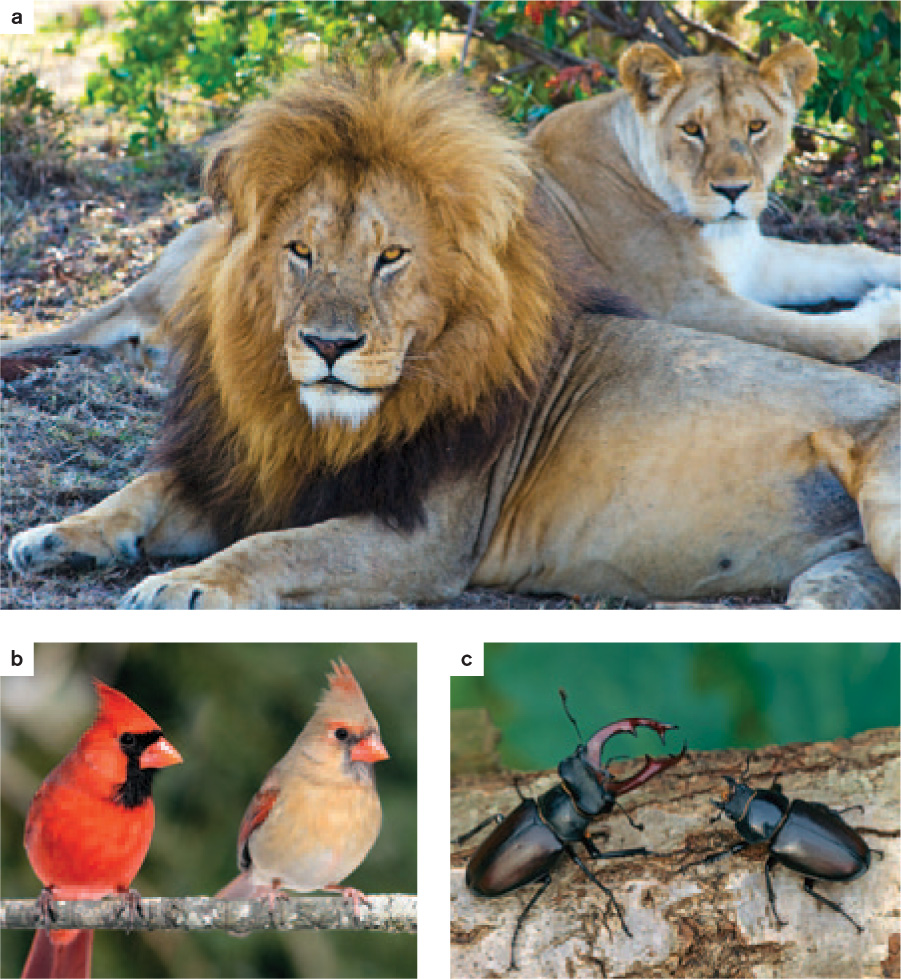45.7 BEHAVIOR AND SEXUAL SELECTION
Throughout this chapter, we have discussed the development of certain behaviors in terms of natural selection. In many species, behavior is also affected by sexual selection, in which traits evolve that increase the probability of finding and attracting mates (Chapter 21). Traits favored by sexual selection sometimes appear to run counter to those favored by natural selection. For example, a peacock’s tail is a compromise between sexual selection, which acts to increase the size and color of the display, and natural selection, which acts to minimize the amount a male invests in its cumbersome and metabolically expensive tail.
45.7.1 Patterns of sexual selection are governed by differences between the sexes in their investment in offspring.
In peacocks, it is the male that has the showy tail, not the female. Male birds often have bright colors, complex songs, and elaborate displays, and females usually do not. Differences in color or size between males and females are examples of sexual dimorphisms, or phenotypic differences between the sexes (Fig. 45.19).

Why do we see such differences between males and females? The key is the level of investment that an individual makes in an offspring. Consider a typical rodent species in which a male mates with a female and then moves on in search of additional mates. The female invests time, energy, and resources in the offspring, both during gestation and, after birth, during lactation. The male, on the other hand, has invested one ejaculate, no more.
In many species, eggs are fertilized externally and neither males nor females care for offspring. But, even in these species, there are differences in parental investment between males and females. Eggs are larger than sperm, and it therefore takes more energy and resources to make eggs than to make sperm. As a result, females still invest more in offspring than males do in these species.
These differences in parental investment lead to different selection pressures on females and on males. The reproductive success of females (that is, her number of offspring) is limited by the number of eggs she can produce or the number of pregnancies she can carry. By contrast, the reproductive success of males is limited by the number of mates. As a result, any trait that increases a male’s ability to attract a female is favored by sexual selection and will evolve over time.
Therefore, sexual selection tends to act more strongly on males than on females, leading to the evolution of the bright colors and striking displays we often associate with male birds. Tellingly, in species in which this typical pattern of parental investment is reversed (the male invests more in the offspring than the female), we see a corresponding reversal of sexual selection (females that are more colorful than males). For example, in phalaropes and sandpipers, males incubate the eggs and females are brightly colored.
45.7.2 Sexual selection can be intrasexual or intersexual.
In On the Origin of Species, Darwin recognized two forms of sexual selection (Fig. 45.20), and later, in The Descent of Man and Selection in Relation to Sex, he developed his ideas more fully. In one form, members of one sex (usually the males) compete with one another for access to the other sex (usually the females). This form is called intrasexual selection since it focuses on interactions between individuals of one sex (Fig. 45.20a). Because competition typically occurs among males, it is in males that we see physical traits such as large size and horns and other elaborate weaponry, as well as behaviors such as fighting. Larger, more powerful males tend to win more fights, hold larger territories, and have access to more females.

Darwin also recognized a second form of sexual selection. Here, males (typically) do not fight with one another, but instead compete for the attention of the female with bright colors or advertisement displays. In this case, females choose their mates. This form of selection is called intersexual selection, since it focuses on interactions between females and males (Fig 45.20b). The peacock’s tail is thought to be the product of intersexual selection: Its evolution has been driven by a female preference for ever-showier tails.
Often, these eye-catching ornaments are associated with elaborate behaviors on the part of the male. Male sage grouse, for example, congregate and put on displays in the mating season so that females can select their mates. Male bowerbirds accumulate shiny, bright objects in carefully tended displays to attract females (see Fig. 42.4b).
In general, therefore, females have evolved behaviors to ensure the quality of their mate (they tend to be choosy), whereas males have evolved behaviors to maximize the number of matings they have (they tend to be competitive). However, as we saw earlier, when the male invests more in the offspring than do the females, there is a reversal of these patterns so that males are choosy and females competitive. In seahorses, for example, males brood the offspring in a specialized pouch and behave in the choosy way we see in females of other species. It is also important to keep in mind that other factors can influence and modify these general behavioral patterns. Nevertheless, sexually selected traits remind us of the power of selection in shaping all kinds of behaviors.